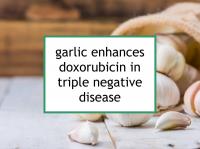Garlic has been linked to reduced risks of both ER+/PR+ and triple negative (ER-/PR-/HER2-) breast cancer, mainly due to its organosulfur compound content (primarily diallyl sulfide, diallyl disulfide, diallyl trisulfide, and ajoene). Now a new study has reported that diallyl trisulfide has synergistic cytotoxic effects in combination with doxorubicin without increasing harm to normal cells.
Garlic compounds have been reported to inhibit DNA synthesis in breast cancer cells, retard their growth, induce apoptosis (a type of programmed cell death), interfere with the cell cycle, and suppress angiogenesis (the formation of new blood vessels). The garlic compound diallyl trisulfide has been shown to suppress breast cancer cell invasion and metastasis, thereby delaying the progression of breast cancer.
Organosulfur compounds are produced upon cutting or chewing garlic. Although some of the anticancer benefits of garlic are retained after cooking or processing it, raw garlic appears to have the most benefits.
Latest research finds diallyl trisulfide potentiates doxorubicin
The study referenced above was designed to examine diallyl trisulfide's role in increasing the treatment effects of doxorubicin chemotherapy. The authors investigated the anticancer potential of treatment with diallyl trisulfide plus doxorubicin using a variety of cell studies, as well as a small study using a mouse mammary tumor model.
The combination of diallyl trisulfide plus doxorubicin was found to inhibit the viability of both ER+/PR+ and triple negative breast cancer cells in a synergistic manner. Diallyl trisulfide enhanced sensitivity to doxorubicin by inhibiting the Warburg effect. The Warburg effect is a form of deviant energy metabolism in which the rate of glucose uptake is significantly increased. Together with activation of key proliferative and survival signaling pathways, the Warburg effect plays a critical role in tumorigenesis. This suggests that compounds targeting the Warburg effect could act as cancer treatment. In fact, the diallyl trisulfide plus doxorubicin combination treatment was shown to induce apoptosis.
To test the combination treatment's in vivo effects, the authors implanted triple negative (MDA-MB-231) cells in the mammary fat pads of NOD/SCID mice (a strain of immunodeficient mice that readily develops tumors when cancer cells are implanted). The mice were divided into five groups of three once the tumors reached 500 mm3: (1) normal control; (2) vehicle (the substance used to deliver treatment) control; (3) doxorubicin-treated; (4) diallyl trisulfide-treated; and (5) combination-treated. Doxorubicin was administered intraperitoneally weekly for four weeks in groups 3 and 5. Diallyl trisulfide was administered intratumorally twice weekly for four weeks in groups 4 and 5. After the mice were sacrificed, their tumors were harvested and analyzed. Group 5's doxorubicin plus diallyl trisulfide treatment was found to significantly inhibit tumor growth compared to the other groups. At the same time, the combination reduced systemic toxicity — the animals in group 5 maintained a stable body weight and showed minimal adverse effects.
The authors conclude that diallyl trisulfide safely increases doxorubicin sensitivity in breast cancer cells by inhibiting the Warburg effect and increasing apoptosis. The findings imply that the combination of doxorubicin plus diallyl trisulfide could represent improved chemotherapeutic efficacy, according to the authors.
Please see our article Foods to eat and avoid during doxorubicin chemotherapy and the garlic food page for more information.
